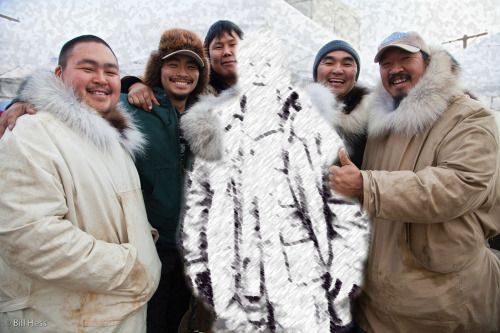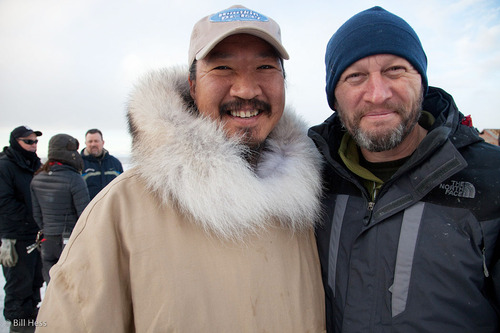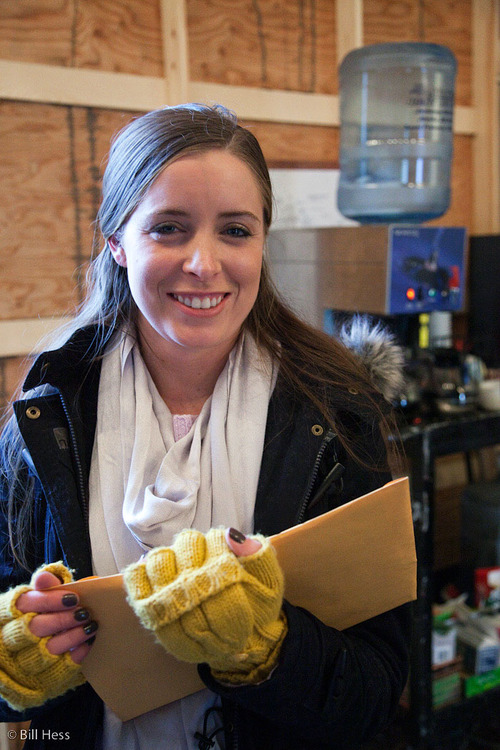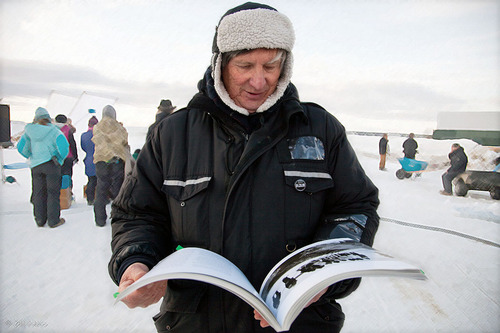I get an invitation to the set for "Everybody Loves Whales" and find that I have been there since the beginning - I wonder, what if?
 Tuesday, November 16, 2010 at 11:04AM
Tuesday, November 16, 2010 at 11:04AM Anyone whose memory reaches back to October, 1988, will remember The Great Gray Whale Rescue that took place on the sea ice near Point Barrow. For those whose memories do not reach back that far and who may not have heard of the event, freezeup came early that year and my friend, Roy Ahmaogak, found three young gray whales trapped in three small holes in slush ice that would soon harden.
What unfolded thereafter was the strangest, most bizarre, wonderful, nightmarish, magnificent, dreamy, spectacle of human good will, pettiness, compassion, selfishness, ingenuity, brutally competitive, cooperative display of kindness and love that I have witnessed - and it was driven by the fact that Everybody Loves Whales.
A most unlikely coalition of Iñupiat whale hunters, the oil industry, Greenpeace, the National Guard, the Reagan White House and the Soviet Union, plus a myriad of ordinary people from all over, came together to try and rescue those three whales.
For two weeks, all the other big stories of the world, including the heated political battle between George H.W. Bush and Michael Dukakis to become the next President of the United States, receded into background noise.
Media from around the world poured into Barrow as the concern and attention of an entire planet of people became focused on those three whales and the efforts to save them.
And I had a front row seat to the drama. I guess I was part of the drama, as I may have been the first person to photograph those whales and I was absolutely the first media person to do so. I alone photographed the first human contact with the whales and the resultant images got onto AP and became the first images of the rescue to be seen in the world's newspapers.
Now, just over 22 years later, Universal Pictures is making a movie based on the rescue, directed by Ken Kwapis, starring Drew Barrymore, John Krasinski, Dermot Mulroney, Ted Danson with a supporting cast of Iñupiat and Yup'ik actors and extras, led by John Pingayak who plays a character loosely based upon the legendary Malik.
Among these actors is my good friend, Art Oommittuk, who has developed a firm relationship with Kwapis.
A couple of weeks ago, Art suggested to Kwapis that he invite me onto the set for Everybody Loves Whales. Kwapis had spent time with my book, Gift of the Whale: The Iñupiat Bowhead Hunt, A Sacred Tradtion, and told Art that he definitely wanted that to happen.
So the invitation came. On Saturday, I was able to accept it.
When I stepped onto the set, I experienced Deja Vu to the extreme. There, in a small area in front of me, was a whale hole on a flat pan of ice rimmed by pressure ridges. When I turned and looked in the other direction, there was a section of downtown Barrow, painted in the very colors that I remember from 22 years ago. It looked so real that I kept wanting to climb the stairs up to Pepe's, go inside, and order some tacos.
I had not been on the scene for more than one minute when Art spotted me and waved. He couldn't come right over, because they were shooting a scene simulating the reaction of the whalers and other rescuers as the Soviet ice breakers rammed the ice nearby. Of course, I wanted to photograph this, but Universal Pictures does not allow any but their own official still photographers to photograph such scenes, so I had to stand with my camera hanging useless at my side and just observe.
After several takes, they took a short break and Art introduced me to Kwapis.
This is them - Art Oomittuk, Iñupiat hunter, artist extraordinaire and now actor, with Ken Kwapis, renowned movie director. He came across to me as a very down to earth individual. He looked like he could have been comfortable on the real ice off Barrow. I could see that he had genuine respect for Art and that he was truly interested in anything I might have to say.
Kwapis said he had been through my book many times, and that it had played a significant role in guiding them as they created the stage for the movie.

This is Hope Parrish, set designer, holding her copy of my book, Gift of the Whale, which she asked me to autograph. As you can see, it is well marked with yellow stickies and it is the most dog-eared copy of the book that I have signed.
She told me that it had been invaluable to her, to many people working on the film, that it was the primary reference for recreating the visuals of the rescue.
The reason that I have lightened, blurred, and distorted the background is because it shows a portion of that part of the set that shows Pepe's renamed, along with a portion of the Top of the World Hotel. Universal Pictures does not want anyone to show pictures of their set to the world just yet. They want the set to be seen for the first time in the trailers that will precede the expected release in early January, 2012.
I got mixed signals about how Universal might react to seeing this small portion of the set off in the background. Some thought it would not be a problem. Some thought it would.
So I decided just to blur and distort it, for now.
Once the movie is released and I do the big series of Gray Whale Rescue blog posts that I plan to publish then, I will post the undoctored version.

We were soon joined by Sarah Regan, who also had a copy for me to sign.

An airplane flew overhead.

Ossie Kairaiuak, a well-known singer and performer in these parts, and David sing a few bars in Iñupiaq of a piece that several of the Native actors on the set spontaneously came up with one day. They were filmed performing and the song is expected to be included in the movie.
Of all the stories that anybody has ever told me regarding their experience with Gift of the Whale, none have moved me more than David's. David has roots in Point Hope, but grew up in Palmer. After he read Gift of the Whale, he decided that he had to go back to Point Hope and go whaling. He did.
He loved the way the experience connected him to his people. He plans to keep doing it.

This is Sarah Conliffe, who I met in the warmup room, where there is much good food to eat, from fresh raspberries and blueberries to peta wraps, delicately braised slivers of beef, rolls, coffee and tea.
Sarah is the costume designer and she, too, wanted me to sign her book.
She, too, described it as an invaluable resource to her - her costume Bible - I believe she said.
Unless I am getting her words mixed up with Parrish's.
I feel like maybe I am coming across as arrogant and boastful, here, and letting all this go to my head.
But it's how it happened.

I was also told that Universal did not want anyone to publish photos of the star actors taken on the set, but that it would be okay if I got personal pictures of my friends in a way that did not really show the set or the big stars.
I was in the process of taking just such a picture when one of the big name actors saw what was going on and jumped right into the middle of the picture.
Again, I got some conflicting advise - some thought it would be okay for me to publish the picture straight, some thought maybe not - so I did it like this. I could make it look better, but I have to catch a plane to Barrow, where, as usual, I will be staying with my friend, Roy Ahmaogak, the man whose discovery launched the episode that led to this movie.
Please come back after the movie is released and then I will show you who the actor in this picture is.
This is Reynolds Anderson, assistant to Ken Kwapis. It was she who met me after I reached the set and who served as my guide for the first hour or two that I was there.
I felt very badly for her at times, as she spent a lot of time just standing patiently by while I talked to other people. Plus, although the day was very warm for this place this time of year, it was not at all warm to a young woman from Southern California.

A young bald eagle flew over head.

This is cinematographer John Bailey. He also came across to me as being a very down to earth, curious, helpful person and he took the time to talk with me over several breaks.
He, too, had kind things to say about my book - and he gave me an idea and said he would help me with it in the future. I have learned never to get my hopes too high about anything until it actually happens, but it sounded good, so I will take him up on that and see if it can be made into anything.

This is Nelson, who also has been doing set work. He showed me a picture from my book that I had taken inside a home where women were sewing skins and told me how he had worked off that picture to create a living room that will appear in the movie. It will not exactly the same, but the element will be there.
I autographed his book, too.
I feel badly, and I thought I entered it into my iPhone, but I cannot remember the name of the woman with him. She also has my book, but did not have it with her. Others told me the same.

To the left is Sandra Murray, who turned the tables on me and interviewed me about my experience during the rescue. Whatever parts of the interview they might find worthy will be incorporated into the DVD and HBO package of the film. Jeff Feller manned the camera and Paul Lawrence handled the sound.

After the interview I hoped in a white van that took me to place where a cajun lunch was being served. I met Heidi there. She had papers for me to sign, stating that it was ok for them to use the interview in their package.

And now, the what if:
Everyone that I met on the set treated me wonderfully. It was flattering and it was good to see that they had been impacted by my work as a team and as individuals and had found inspiration and guidance in it to help them carry their own work forward.
This felt good to me - and it was fun. Yet, I cannot help but wonder, what if?
After my book was released, my publisher, Sasquatch Books, attempted to sell the movie rights to it in Hollywood, but the effort didn't pan out. Later, my niece, Shaela Cook, who is making a career in Hollywood, decided that she wanted to make a movie based on Gift of the Whale.
She worked hard at it, and presented it to various people in Hollywood and got some responses that were, at first, encouraging, but that ultimately led to nothing.
So what if?
What if either of these efforts had succeeded?
The story Hollywood settled upon is a love story, based loosely on one that actually happened during the rescue, one that was written up in another book.
I am not certain about this, but I understand that a photographer also plays a significant role in the film - a photographer who documented the rescue effort from beginning to end. I am not certain if this is a still photographer or a video photographer - or even if there truly is such a character - but there was only one photographer of any kind who was there at the beginning and at the end of the gray whale drama, and that was me.
Many others, from all over the world, joined in between the beginning and end points. But I am the only one who shot the beginning, the middle, and the end. The only one.
So what if it had been my book that had been made the focus of the story?
There is a pretty good chance that I would now have the necessary resources to spend a year or so trying to figure out how to build this blog and its evolution into what I would like it to become.
That's what if.
But it did not happen that way. There is no point in lamenting.
So, when the movie is released, I will go and enjoy. It will not matter to me that the story is a different story than the one that I saw unfold. I will enjoy it. I have this feeling that the movie is going to be good - perhaps even excellent, a huge hit. I will take Margie and we will eat popcorn, and chocolate covered peanuts.
The movie will give me an excuse to do what I always wanted to do but never did - to tell the gray whale rescue story indepth, as I saw and experienced it. I did not tell it in depth in Gift of the Whale, because I had space enough only to devote one chapter to it.
There will be space enough in this blog - or whatever this blog has evolved into by then. I will spread the telling out over two weeks - the same approximate time as it took for the rescue effort to unfold.
I will tell the story then - in early January, 2012, or whenever the movie is released.
So please come back then.
The bridge above, by the way, crosses over the place where the van took me for the Cajun lunch, which was excellent. I saw Art and some of friends in there and was going to join them, but the publicist asked me to join him, as he had many questions for me.
I did my best to answer all of them.
they will appear larger and look better






























